Abstract
GCC is a sub-region of the ESCWA economic realm that is located in the Middle-East, and consisting of six members that include Qatar, The Kingdom of Saudi Arabia, Bahrain, Oman, Kuwait and the United Arabs Emirates (UAE). This region is located in the arid ecosystem and one plight that is common to the entire members is the scarcity of renewable water resources. As a result, they have resorted to investing in desalination technologies (MED, RO, MSF) to suffice the demand of the ever increasing population. Nonetheless, this journey has never been that rosy since there are a number of challenges that have come their way. Among the challenges include the unit cost (OPEX and CAPEX), environmental pollution, and also the number of contracted capacity.
However, it is upon the management to frame reliable policies so as to overcome these challenges lest the problems persist. For instance, in Abu Dhabi, in order to realize Vision 2030, then there is need to recycle wastewater for use in agricultural production instead of using desalinated water that comes directly from the plants.
Introduction
GCC (Gulf Cooperation Council) is an economic region consisting of six Middle-East economies including Qatar, The Kingdom of Saudi Arabia, Bahrain, Oman, Kuwait and the United Arabs Emirates (UAE). These countries are grouped together since they have a lot in common. Ideally, these nations have comparable socio-economic situation and oil exploration forms the backbone of their economies, spanning four decades back. Importantly, merchandise in oil-related products dominates their export markets, accounting for more than 90% of their total exports. One major resource that has been impeding the faster development of this region has been the scarcity in natural water resources at the backdrop of increasing demand (Al-Rashidi, 2008). The increasing demand is a consequence of population growth, and as such, the surface water resources are now exhausted. In some countries, the aquifers are already drained. To this end, to supplement the declining fresh water resources, the GCC countries have resorted to investing, massively, in desalination plants much to their success. The desalination plants invested in GCC countries typify a successful project that has lived up to its expectation of serving its population with continuous supply akin to economies that are sufficiently endowed with natural and renewable water resources (Hanbury, 2010).
According to a research conducted by the World Health Organization (WHO), this region, located within an arid ecosystem, has already hit the water scarcity line of less than 1000 m3 per year per capita. In area, this region covers a space of approximately 2.55 million Km2 and it has a common climate with a few surface water resources. The available surface water resources are localized along the coasts of both Saudi Arabia and Oman but to the south. In a synopsis, this realm represents the harshest of the entire realms making up the world. This region is endowed with the least fresh water resources around the world, accounting for less than 370 cubic metres. With a growing population, it is projected that these resources will decrease to less than half the current capacity by the year 2030 when the population will be standing at 56 million people. With these facts, it goes without saying that the GCC countries have an uphill task of efficiently managing the limited water resources. This is why they have taken to desalination plants to meet the demand (Mezher & Fath, 2011).
Desalination plants have been part and parcel of the economies forming up the GCC, supplying both municipalities and industries for the past two to three decades. Overreliance to the same is projected to increase as the population swells. Among the common desalination processes employed include Multi-Stage-Flash (MSF), Multiple-effect Desalination (MED) and Reverse Osmosis (RO). Of the three, the later technology is becoming common to the region owing to the fact that it is cost-efficient and more reliable. While the amount of desalinated water consumed the world over is immaterial, this region accounts for almost 100% of their total needs. According to Global Water Intelligence (GWI) report, “the cumulative capacity of the entire desalination plants contracted in the GCC countries since the year 1994 was 24 million cubic metres per day by 2010” (Al Zawad, 2008).
The energy requirement of any given technology is vital in determining the process economies since any slight variation in the oil prices has a greater effect on the production cost. Moreover, the more intensive a process is in terms of energy requirements the more are the emissions (CO2 gas) released to the environment. Importantly, the cost of desalinated water is dependent on a myriad of factors that can be grouped as either capital related (CAPEX) or operation related (OPEX).
In the face of all these challenges comes another factor that is the competing demand from various sectors of the economy. For ages, GCC countries have successfully managed to balance their limited water resources among domestic, animal and agricultural sectors. Nonetheless, in the past 50 years, urbanization, industrialization and population growth have entered the fray. Today, these economies grapple with the rising competing demands, for instance, “urban versus rural and human versus industrial among others” (Hoepner & Lattemann, 2002).
With the background information on the water resource situation of this region, we can objectively analyze the desalination plants in the GCC countries. As such, the rest of the literature in this paper will focus on; the cumulative contracted capacity, number of contracted plants, proportions of different technologies, daily water production volumes, the cost per unit and the future projections in terms of demand/supply. Moreover, this paper will suggest policy initiatives for Abu Dhabi Vision 2030.
The cumulative contracted capacity and the number of contracted plants
The history of desalination technology stretches way back in history. However, in the modern history, Bahrain and Kuwait represent the first members of the GCC countries to have enjoyed desalination technology in the name of multi-effect distiller (MED). Kuwait is, too, the first member of the GCC countries to launch the MSF in the mid twentieth century. Currently, the number of plants installed in the MENA (Middle East and North Africa) region is a manifestation of the increasing demand of freshwater in this water-scarcity region. The most striking feature, however, is the increasing number of the contracted firms in this region. When you look at the numbers of the contracted firms in the MENA region in the figure 1 below, it goes without saying that this number is relatively high in the GCC countries. Among the first six nations of the MENA region with high numbers of contracted capacity, four hail from the GCC sub-region with the Kingdom of Saudi Arabia leading the pack.
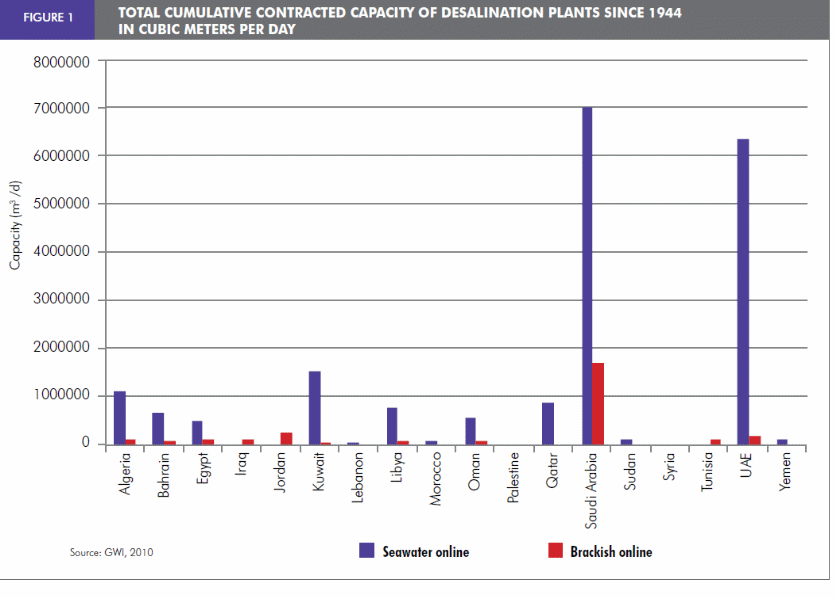
As manifested in the figure 2 below, the number of contracted firms in this region is projected to increase in the subsequent decade. This large expansion “requires a review of the present policies and practices including how to increase local capacity, knowledge, and added value to the local economies” (AL-Rashed, 2000).
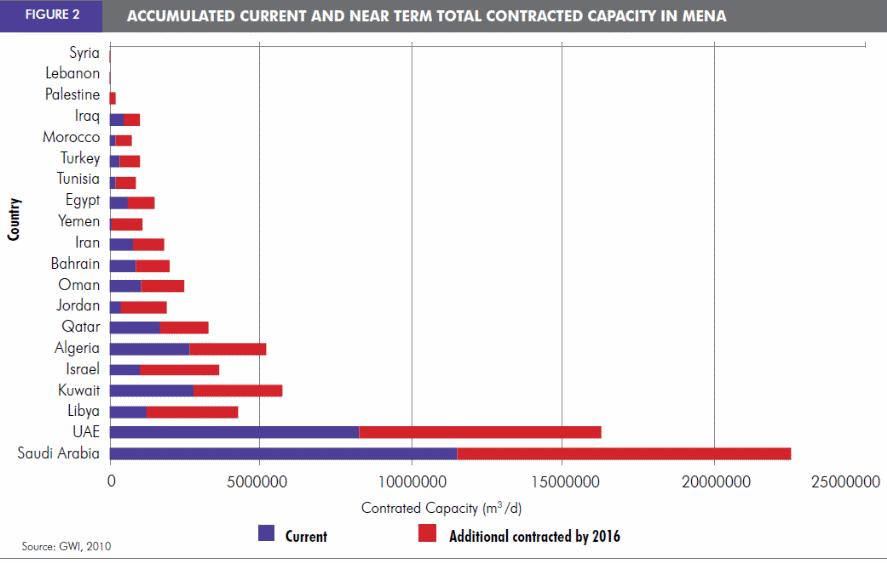
The local capacity in this realm is biased on only operations and maintenance, assuming manufacturing and design yet this is a region that is highly dependent on the desalination technology to provide freshwater for both domestic and industrial use. Even though there are exceptional local-based engineers in this region, they are not adequate to meet the ever soaring needs of the region. Not unless the governments forming up the GCC region do something to support the local talent, the situation is likely to remain delicate like in other technology-based industries which are dependent on imported talent.
Among the policies proposed by IWRM (Integrated Water Resource Management) to curb this trend is to seal all the water leakages present in the current facilities before engaging in a white elephant project of contracting more capacity. To this end, IWRM explains that sealing the leakages is relatively cheaper, and it will give a true picture of the actual capacity that is required for addition.
Proportions of different technologies
Reverse Osmosis, a membrane technology, has dominated the world desalination industry over the past three decades as manifested in the figure 4 below. Nonetheless, in the ESCWA (Economic and Social Commission for Western Asia) region, and more so in the GCC economies, thermal technologies are dominant. This is exhibited in the figure 5 below (Sommariva, 2010).

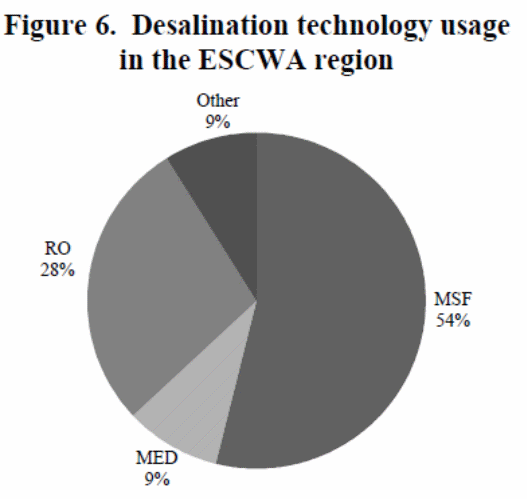
Thermal technologies are a common place in the GCC region owing to the fact that many of the firms in this region optimize on the fuel to co-generate both water and electricity. However, in the regions where electricity is available and the feed water is brackish, membrane technology comes in handy. Ideally, contemporary commercial technologies in place today can be classed as either thermal or membrane technologies. The thermal technologies include MSF, MED and VC (Vapor Compression). On the other hand, the membrane technologies include SWRO (Seawater Reverse Osmosis), BRO (Brackish Water Reverse Osmosis), ED (Electro-dialysis) and NF (Nano-Filtration).
The membrane technology to be adopted is dependent on the degree of salinity in the brackish water. While ED is more efficient for low salinity brackish water, RO is more efficient for higher salt concentration feed-water. In the MENA region, the MSF technology is the dominant technology. The figure 6 below shows proportions of a diversity of technologies applied in this region but cumulatively since the year 1944. However, over the years, RO has been slowly gaining dominance.
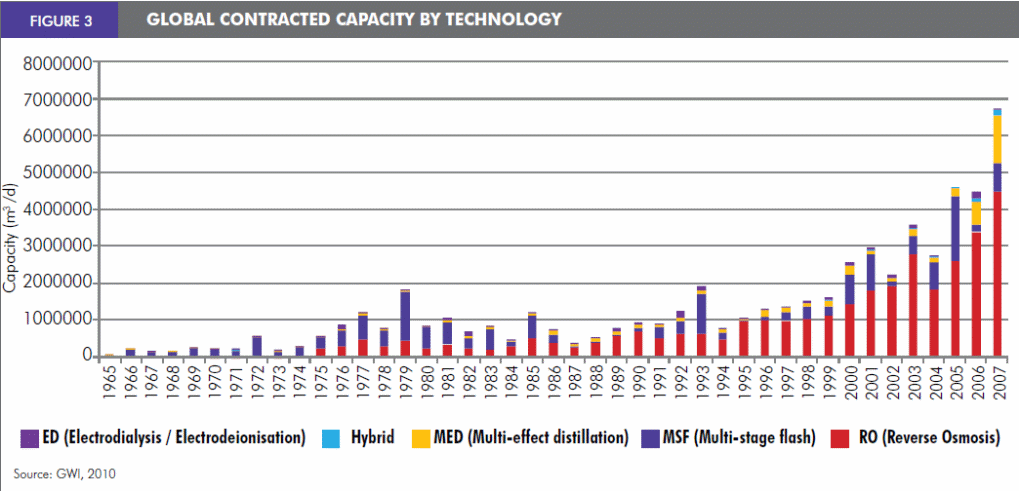
RO is slowly gaining dominance owing to the fact that it is cost-efficient, and of late, there has been an improvement in the membrane technology to enhance its efficiency. Contemporary applications adopt hybrid technologies which combine both thermal and membrane technologies to achieve efficiency, low-cost operations and to co-generate electricity. Some of the hybrid combinations include MED/RO and MSF/RO. In the meantime, there is a pilot project to determine the competitiveness of NF/MSF/MED/RO combination which is set to revolutionize the desalination technology. The world over, there are a number of novel desalination technologies that are slowly being developed. These technologies include “membrane distillation, carbon nanotube membranes, aquaporin (biomimetics) membrane, forward osmosis, and electro-dialysis/deionization” (Dawoud & Al-Hussayen, 2012). Nonetheless, skeptics doubt whether these technologies would have a significant effect in the desalination industry.
The GCC sub-region has the highest concentration of desalination plants worldwide. The Arabian Gulf Coast is shared among seven ECSWA economies. Of these members, it is only one member who does not belong to the GCC sub-region. As a matter of fact, for most of the GCC members, the Arabian Gulf is the only source of their feed-water. To these nations, most of the plants are stationed near the major cities which are always located at the coastal line (figure 6). For instance, in Saudi Arabia, they are located in Al-Jubail and Al-Taweelah among other coastal cities. Figure 6 shows the locations of different plants by technologies located along the coastal strip of the Arabian Gulf.
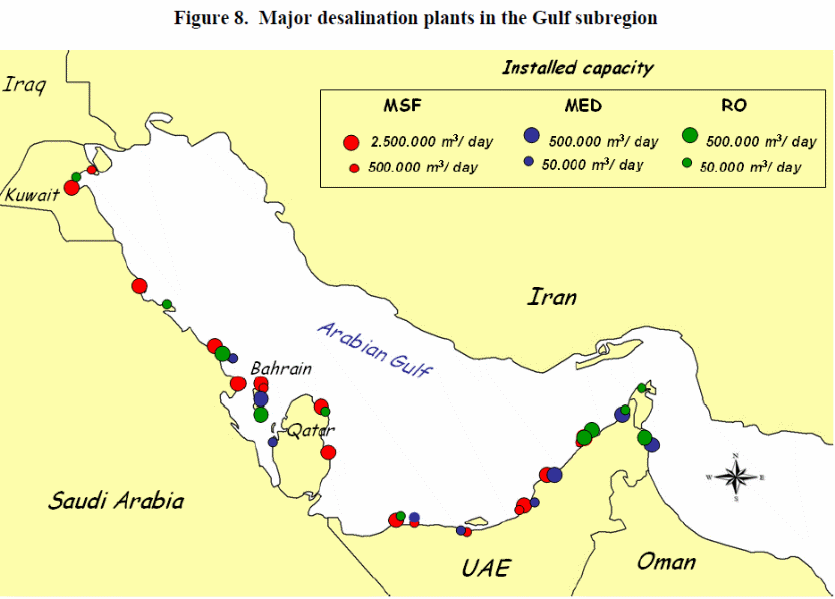
Daily water production volumes
The daily water production in the GCC countries is dependent on the demand, a function of population growth. Water demand in this region is can be grouped into three sectors including domestic, agricultural and industrial sectors. Figure 7 below is a depiction of the requirements per sector in the ESCWA region. Individually, most countries align their specific requirements with the regional demand. An economy in the GCC region that doesn’t fit well in the regional sector includes Bahrain which uses only 50% of its requirements to agriculture.
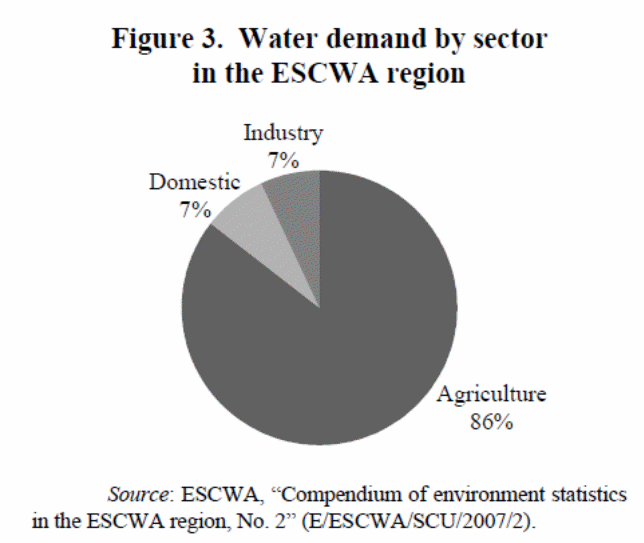
In the GCC region, the average consumption rate takes approximately 80% of the total requirements. This figure is forecasted to increase by at least 40% come 2020. However, the agricultural sector accounts for a paltry 10% of the GDP in the entire region. The investors in the agricultural sector have continued to be skeptical about this industry because the ratio of the “agricultural GDP to agricultural the labor force has always been below 1.0 in some GCC countries” (Abdulrazzak, 1995). As such, investors in the sector are seeing an investment in the industry as beneficial to labor industry. As for the domestic demand, the consumption rate is dependent on the standard of living (figure 8). From the figure (8) below, it is evident that the most of the GCC nations which have higher standards of living consume a lot of water per day.
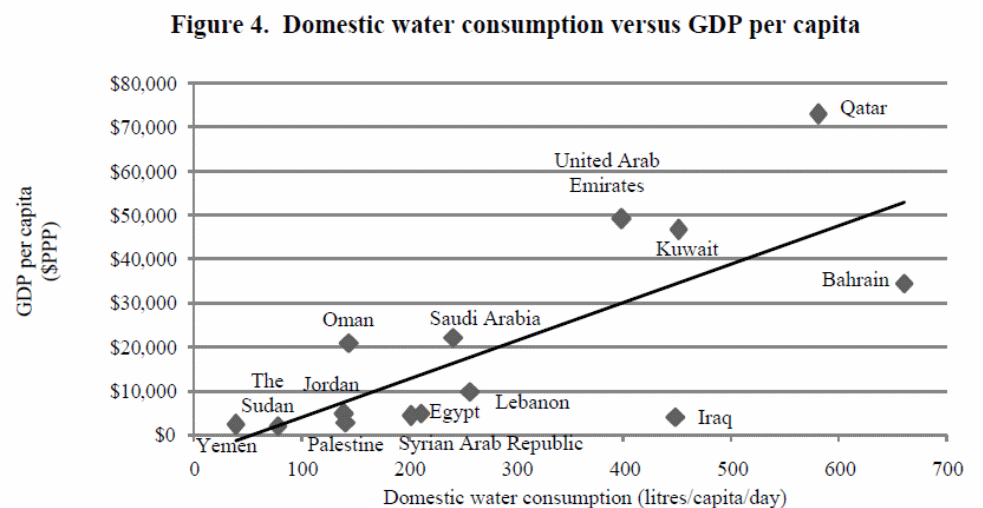
Population is one factor that has led to increased water demand. As typified in the figure 10 below, the population in the GCC sub-region continues to soar. As such, the water demand is projected to increase as the population swells to the 56 million mark by 2030. With these projections, the pressure is directed to the governments making up this region to ensure a regular and constant supply of water to its citizens. As shown in figures 1 and 2 above, the numbers of the contracted plants continue to increase to meet the rising demand.
The cost per unit
Desalination industry is a capital intensive project that requires optimization of factors to limit on the cost of the product. Those technologies with lower operation cost (OPEX) options always tend to be responsive to both the operating skills and the quality of the raw material (feed water). The CAPEX is a function of the quality of the raw material, “production capacity, required infrastructure, plant efficiency, material selection and other location factors” (Dawoud, 2006). For majority plants, the CAPEX always ranges between $1000 and $2000 per cubic metres. Both the CAPEX and OPEX are vital in determining the final cost of water. Also, as typified in the figure 9 below, the unit cost is dependent on the technology which is proportional to the cost of oil.
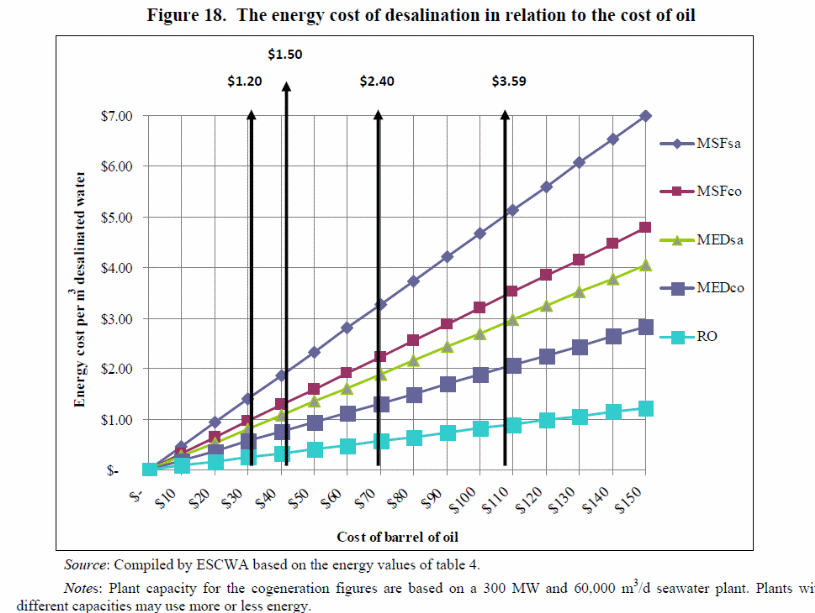
Also, as typified in the figure 10 below, OPEX is a function of the technology. To this end, the RO technology attracts the least operation cost.

As outlined above, cost management is very sensitive in determining the final cost of the product. A “different policy discourse can have a massive effect on the unit cost” (GWI, 2010). For instance, government agencies need to shift focus to being purchasers of the product (water) rather than procurers of plants. This will enhance the establishment of most efficient technologies. Furthermore, this would shift the government roles from being an operator to a regulator.
The future projections in terms of demand and supply
The desalination plants in the GCC region are meant to meet the current and the future water demand due to increasing population. Of the GCC countries, Kuwait and Saudi Arabia are first nations to launch the modern desalination plants back in the 1950s. Among the desalination plants gracing the world today, 50% hail from this region. The desalination plants with their unique technologies are expected to increase in this realm in the future owing to increasing demand. The ever increasing population (Figure 11) coupled with the scarcity of non-renewable water resources are the reasons that is an increase in desalination plants.

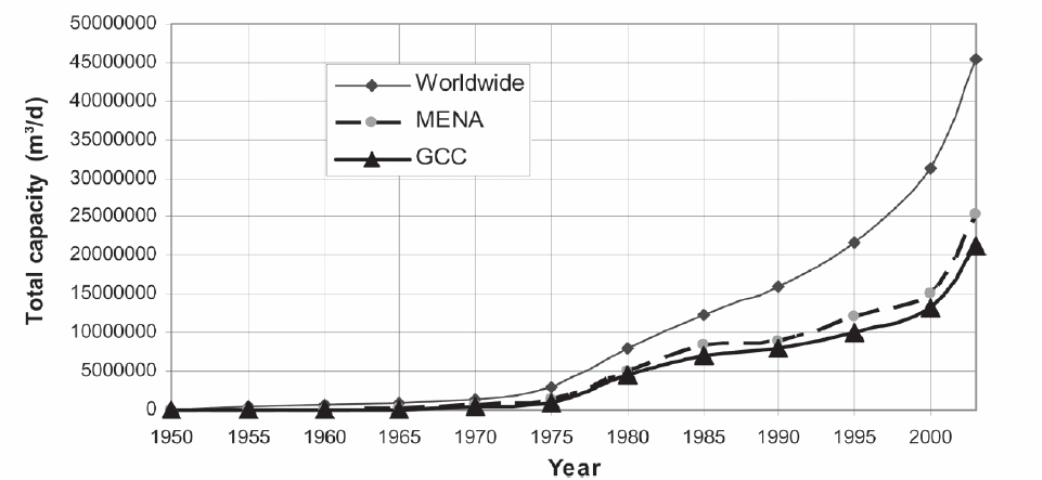
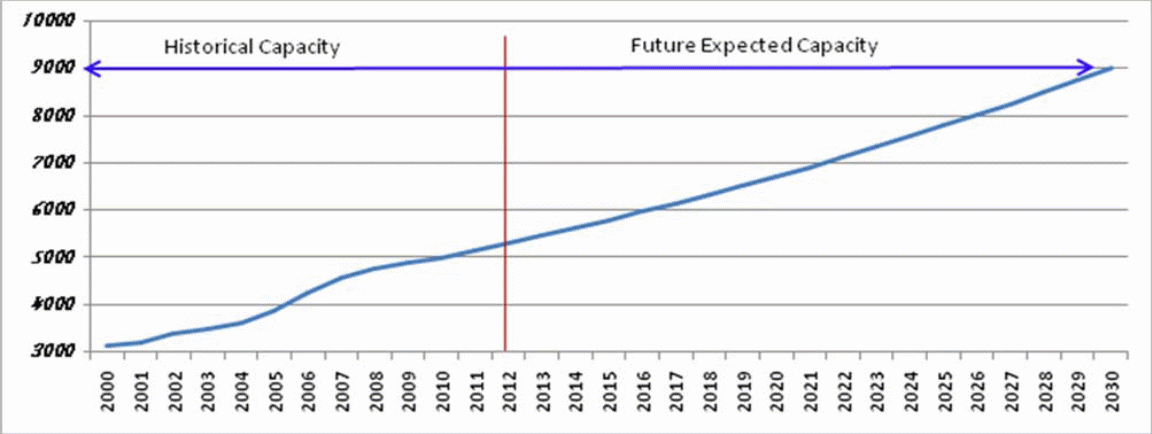
Even as investors struggle to meet the ever increasing water demand, with the above projections there seem to be a looming battle between stakeholders- investors versus environmentalists (Dawoud & Al-Mulla, 2012). While desalination plants offer socio-economic benefits by providing potable water devoid of affecting the freshwater ecosystem, the niche that faces potential destruction is the marine ecosystem.
Policy initiatives for Abu Dhabi Vision 2030
In order for Abu Dhabi to realize Vision 2030 of establishing a sustainable economy, then availability of water, a sector vital to its economy need to be effectively managed (World Bank, 2007). Since the dominant technology in this region is thermal-related, there is need to limit on the over-reliance on fossil fuel (a non-renewable energy). This can be minimized through recycling of wastewater. The product (water) can be useful for both agriculture and landscaping. Also, this vision can be realized when initiatives are in place to minimize losses emanating from leakages and wasteful usage. Control of wasteful usage of water can be realized through public awareness. Finally, the government ought to encourage potential investors to employ renewable energy-based technologies in desalination plants, an environmentally sound technology (Dawoud & Allam, 2006).
References
Abdulrazzak, J. (1995). Water supplies versus demand in countries of Arabian Peninsula. Journal of Water Resources Planning Management ASCE, 121(3) 227–234.
Al Zawad, M. (2008). Impacts of Climate Change on Water Resources in Saudi Arabia. New York: New York University.
AL-Rashed, H. (2000). Water Resources in the GCC Countries: An Overview. Chicago, IL: University of Chicago Press.
Al-Rashidi, M. (2008). Sea surface temperature trends in Kuwait Bay, Arabian Gulf Background Report to Seminar on Water and Energy Linkages in the Middle East. Stockholm: Stockholm International Water Institute.
Dawoud M., & Allam, A. (2006). “Using renewable energy sources for water production in arid regions: GCC countries case study”, Arid Land Hydrogeology, 2(9), 56-90.
Dawoud, M. (2006). “The Role of desalination in the augmentation of water supply in GCC countries”, Desalination, 186 (34), 187-198.
Dawoud, M., & Al-Hussayen, A. (2012). Strategic Water Reserve: New Approach for Old Concept in GCC Countries. New York, NY: Russell Sage Foundation.
Dawoud, M., & Al-Mulla, M. (2012). Environmental impact of seawater desalination: Arabian Gulf Case study. International journal of environment and sustainability, 1 (3), 22-27.
GWI. (2010). Water Market Middle East 2010. Geneva: Global Water Intelligence.
Hanbury, W. (2010). Personal communication with William Hanbury. New York, NY: Russell Sage Foundation.
Hoepner, T., & Lattemann, S. (2002). “Chemical impacts from seawater desalination plants— a case study of the northern Red Sea,” Desalination, 152(56), 133–140.
Mezher, T., & Fath, H. (2011). Techno-economic assessment and environmental impacts of desalination technologies. Journal of Desalination, 266 (97), 263-273.
Sommariva, C. (2010). “Efficiency improvements in power desalination for better environmental impact.” Desalination, 102 (35), 13–40.
United Nations. (2009). ESCWA water development report 3: Role of desalination in addressing water scarcity. New York: Dover.
World Bank (2007). Making the most of Scarcity: Accountability for Better Water Management in the Middle East and North Africa. Washington, D.C: World Bank.